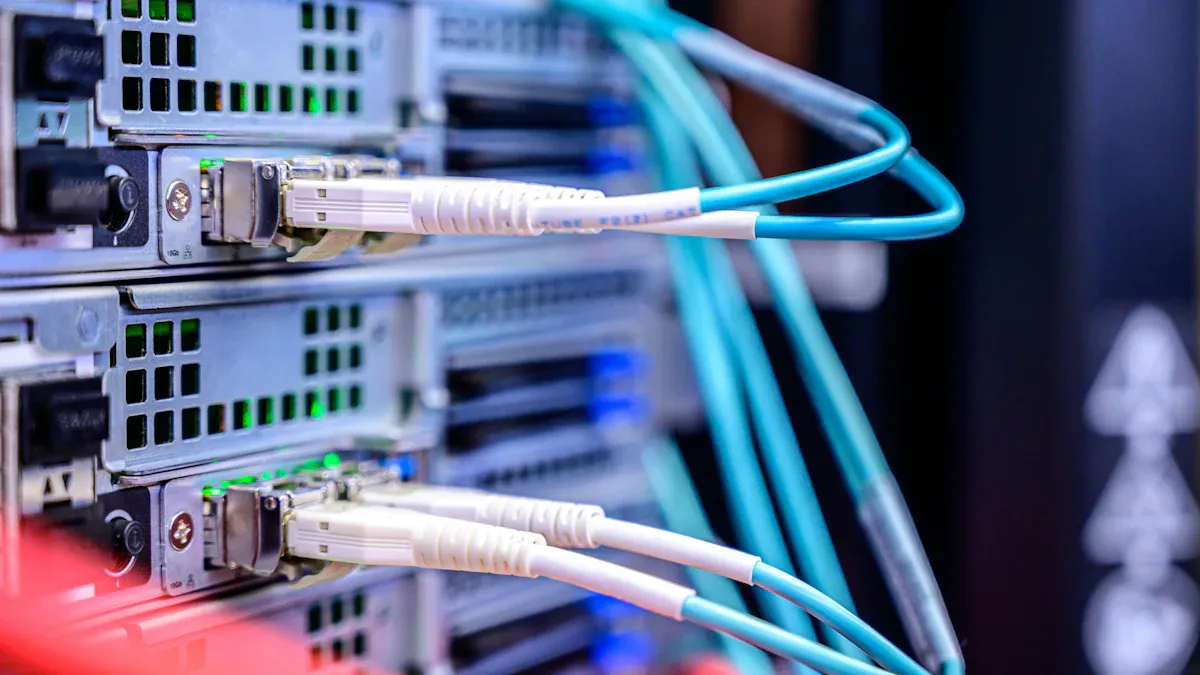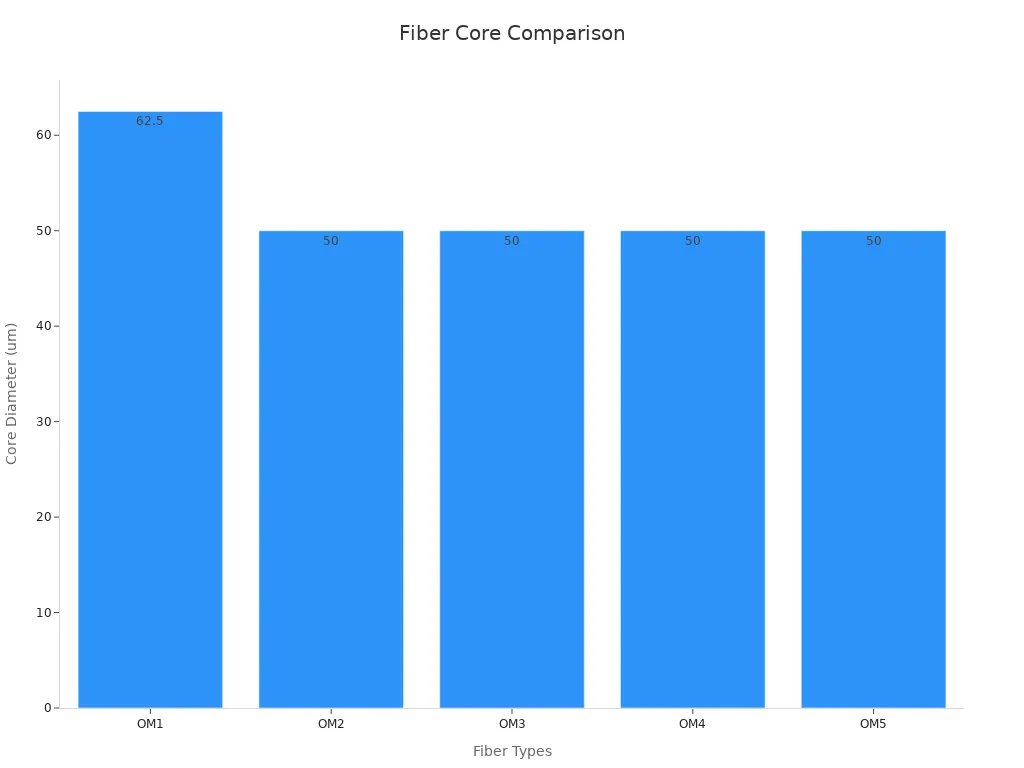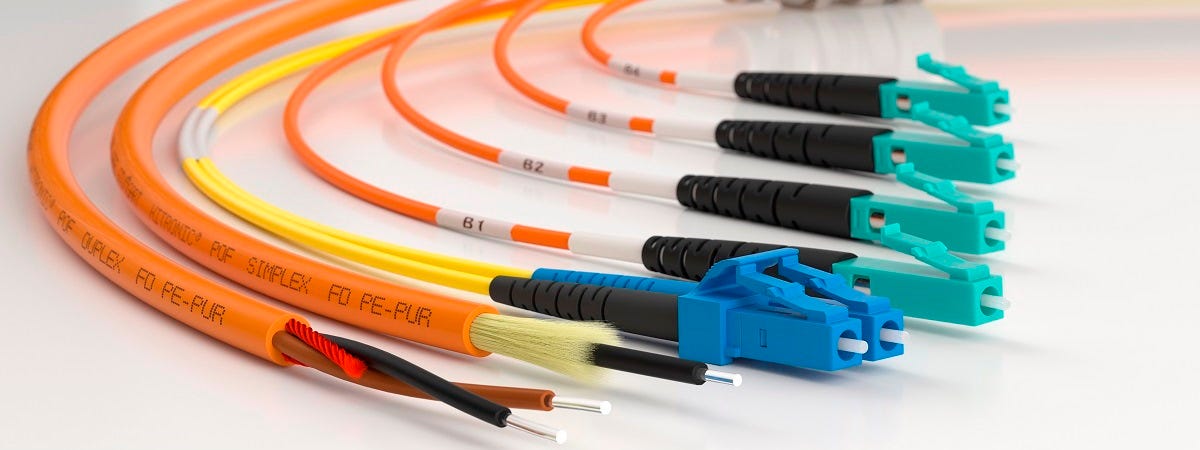
OM5 multimode fiber cable delivers a robust solution for enterprises seeking high-speed connectivity and scalability. Its enhanced modal bandwidth of 2800 MHz*km at 850nm supports higher data rates, while Shortwave Wavelength Division Multiplexing (SWDM) technology optimizes existing optical fiber cable infrastructure. By enabling multiple wavelengths and future-proofing networks for 40G and 100G Ethernet, OM5 ensures seamless scalability. Enterprises can also benefit from its compatibility with advanced technologies like armored fiber cable and ADSS cable, which enhance durability and reliability in demanding environments. This multimode fiber cable is designed to meet the evolving needs of modern communication systems.
Key Takeaways
- OM5 fiber cable allows fast data speeds up to 400 Gbps. It is great for today’s business networks.
- Switching to OM5 can lower costs by using fewer cables. This makes it more budget-friendly.
- OM5 works well with new technologies, helping businesses prepare for the future.
Understanding OM5 Multimode Fiber Cable

Overview of OM5 Specifications
OM5 multimode fiber cable represents a significant advancement in optical communication technology. It is specifically designed to support Shortwave Wavelength Division Multiplexing (SWDM), enabling multiple wavelengths to transmit over a single fiber. This capability enhances bandwidth efficiency and reduces the need for additional cabling.
Key technical specifications of OM5 include:
| Aspect | Technical Specification/Benchmark |
|---|---|
| Attenuation | Should not exceed 0.3 dB/km for OM5 fiber |
| Insertion Loss | Less than 0.75 dB for cleaned connectors |
| Return Loss | Greater than 20 dB for cleaned connectors |
| Splice Loss | Should remain below 0.1 dB |
| Connector Loss | Should remain below 0.3 dB |
| Total Network Loss | Should not exceed 3.5 dB over specified distances |
| Environmental Monitoring | Temperature: 0°C to 70°C; Humidity: 5% to 95% non-condensing |
These benchmarks ensure OM5 delivers reliable performance in demanding environments, making it an ideal choice for enterprises.
Advantages Over OM1-OM4 Standards
OM5 outperforms earlier multimode fiber cable standards in several key areas. Unlike OM1 and OM2, which are limited to legacy systems, OM5 supports data rates up to 400 Gbps. Its enhanced modal bandwidth of 2800 MHzkm at 850 nm surpasses OM3 and OM4, which offer 1500 MHzkm and 3500 MHz*km, respectively.
| Fiber Type | Core Diameter (micrometers) | Bandwidth (MHz*km) | Maximum Speed | Typical Uses |
|---|---|---|---|---|
| OM1 | 62.5 | 200 at 850 nm, 500 at 1300 nm | Up to 1 Gb/s | Legacy systems |
| OM2 | 50 | 500 at 850 nm, 500 at 1300 nm | Up to 1 Gb/s | Phased out in modern installations |
| OM3 | 50 | 1500 at 850 nm | Up to 10 Gb/s | Data centers, high-speed networks |
| OM4 | 50 | 3500 at 850 nm | Up to 100 Gb/s | High-performance data centers |
| OM5 | 50 | 2800 with SWDM capabilities | Supports multiple wavelengths for higher data rates | Advanced data centers requiring future-proof solutions |

OM5 also reduces infrastructure costs by enabling the use of fewer fibers for higher data rates, making it a cost-effective solution for enterprises.
Applications in Modern Enterprise Networks
OM5 multimode fiber cable is widely adopted in various enterprise applications due to its high capacity and scalability.
- Data Centers: OM5 supports cloud computing and virtualization with data speeds up to 400 Gbps. Its enhanced modal bandwidth ensures seamless scalability for future upgrades.
- Telecom and Broadband: The cable optimizes bandwidth use and improves efficiency, supporting up to 400 Gb/s within the 850 nm to 950 nm spectrum.
- Enterprise Networks: OM5 future-proofs network infrastructure, ensuring compatibility with emerging technologies and high-speed connections.
| Application Area | Key Benefits | Technical Specifications |
|---|---|---|
| Data Centers | High capacity, wide bandwidth, scalability, supports cloud computing | Data speeds up to 400 Gbps, Enhanced Modal Bandwidth (EMB) 2800 MHz*km at 850 nm |
| Telecom and Broadband | Capacity and efficiency improvements, optimized bandwidth use | Supports up to 400 Gb/s, operates within 850 nm to 950 nm spectrum, longer reach than OM3 or OM4 |
| Enterprise Networks | Increased bandwidth, future-proofing network infrastructure | EMB of 2800 MHz*km, ensures viability for high-speed connections |
OM5’s versatility makes it a strategic investment for enterprises aiming to enhance their network performance and reliability.
Cost Analysis of Upgrading to OM5 Multimode Fiber Cable
Installation and Deployment Costs
Upgrading to OM5 multimode fiber cable involves initial installation expenses that vary based on the complexity of the network infrastructure. Skilled labor is essential for proper deployment, as technicians must ensure precise splicing and connector alignment. While this increases upfront costs, enterprises can mitigate expenses by opting for pre-terminated cables, which reduce installation time and labor requirements.
- Material Costs: OM5 fiber optics are more expensive than copper cables due to advanced materials, but prices have decreased with technological advancements.
- Labor Costs: Skilled technicians are required for installation, which can increase costs. However, pre-terminated cables can significantly reduce labor expenses.
Despite these costs, the long-term benefits of OM5, such as reduced downtime and enhanced performance, justify the investment.
Equipment and Hardware Investments
Transitioning to OM5 multimode fiber cable requires compatible hardware upgrades. Enterprises must invest in transceivers, patch panels, and other network components designed to support OM5′s advanced capabilities. These investments ensure optimal performance and compatibility with high-speed applications.
- Transceivers: OM5-compatible transceivers enable efficient data transmission across multiple wavelengths, maximizing bandwidth utilization.
- Patch Panels and Connectors: Upgraded components ensure seamless integration with existing infrastructure while maintaining low insertion loss.
Although these hardware investments may seem substantial, they eliminate the need for frequent replacements, offering cost efficiency over time.
Operational and Maintenance Expenses
OM5 multimode fiber cable offers significant operational savings due to its high bandwidth and low latency. Enterprises can achieve cost efficiency by reducing the number of fibers required for similar speeds. Regular maintenance practices, such as biannual inspections and cleaning, ensure long-term performance.
| Metric | Description |
|---|---|
| Cost Efficiency | OM5 reduces operational costs by requiring less hardware and fewer fibers for high-speed connectivity. |
| Maintenance Practices | Routine inspections and cleaning procedures enhance durability and performance. |
| Inspection Frequency | Biannual visual inspections detect damage and environmental concerns. |
| Cleaning Procedure | Use lint-free wipes and isopropyl alcohol to maintain insertion loss < 0.75 dB and return loss > 20 dB. |
By incorporating these practices, enterprises can minimize downtime and extend the lifespan of their multimode fiber cable infrastructure.
Benefits of OM5 Multimode Fiber Cable
Increased Bandwidth and Transmission Speed
OM5 multimode fiber cable delivers unparalleled bandwidth and transmission speed, making it a cornerstone for modern enterprise networks. Its ability to support Shortwave Wavelength Division Multiplexing (SWDM) allows multiple wavelengths to transmit over a single fiber. This innovation significantly enhances data rates, enabling speeds of up to 100 Gbps over distances of 100 meters. Enterprises can leverage this capability to meet the growing demand for high-speed data transmission in sectors like telecommunications and data centers.
Scalability for Growing Enterprise Needs
The scalability of OM5 multimode fiber cable positions it as a future-ready solution for enterprises. The global market for multimode fiber cables, including OM5, is projected to grow at a compound annual growth rate (CAGR) of 8.9% from 2024 to 2032. This growth reflects the increasing need for high-speed connectivity in expanding industries. OM5’s compatibility with SWDM technology ensures that enterprises can scale their networks without extensive infrastructure changes, accommodating future bandwidth requirements seamlessly.
Reduced Downtime and Enhanced Reliability
OM5 multimode fiber cable minimizes downtime through its robust design and advanced maintenance practices. Regular visual inspections, attenuation monitoring, and cleaning procedures ensure optimal performance. For instance, maintaining an insertion loss below 0.75 dB and a return loss above 20 dB enhances reliability. These measures, combined with OM5’s low attenuation rate of 0.3 dB/km, reduce the risk of signal degradation, ensuring uninterrupted network operations.
Future-Proofing for Emerging Technologies
OM5 multimode fiber cable is engineered to support emerging technologies like 40G and 100G Ethernet. Its optimization for wavelength division multiplexing (WDM) enables multiple wavelengths to operate over a single fiber, ensuring compatibility with ultra-high-speed data transmission. As data centers transition to 400G networks, OM5’s ability to handle higher bandwidths and longer distances without signal loss makes it an essential investment for enterprises aiming to future-proof their infrastructure.
ROI Calculation for OM5 Multimode Fiber Cable
Framework for ROI Estimation
Calculating the return on investment (ROI) for OM5 multimode fiber cable involves assessing both tangible and intangible benefits. Enterprises should begin by identifying the total cost of ownership (TCO), which includes installation, hardware, and maintenance expenses. Next, they should evaluate the financial gains derived from increased efficiency, reduced downtime, and scalability. A simple ROI formula can be applied:
ROI (%) = [(Net Benefits - TCO) / TCO] x 100
Net benefits encompass cost savings from operational efficiency and revenue growth due to enhanced network performance. By applying this framework, enterprises can quantify the value of upgrading to OM5.
Tangible Benefits: Cost Savings and Efficiency
OM5 multimode fiber cable delivers measurable cost savings and operational efficiencies. Its ability to support higher data rates with fewer fibers reduces installation and material costs. The following table highlights key metrics that demonstrate these tangible benefits:
| Metric | Description |
|---|---|
| Increased Bandwidth | OM5 supports data rates of up to 100 Gbps with distances up to 150 meters, enhancing capacity. |
| Scalability | OM5 allows for capacity expansion by a factor of 4 compared to OM3/OM4 without additional cables. |
| Cost Efficiency | Reduces installation costs by requiring fewer fibers due to SWDM technology. |
| Extended Reach | Existing links can operate at higher speeds and longer distances, improving network efficiency. |
| Backward Compatibility | OM5 is compatible with existing OM3/OM4 systems, minimizing transition costs and downtime. |
Additionally, OM5 integrates seamlessly with existing LC connectors, reducing installation time and costs. Its backward compatibility allows enterprises to upgrade gradually, spreading financial investments over time.
Intangible Benefits: Competitive Edge and Customer Satisfaction
Beyond measurable savings, OM5 multimode fiber cable provides intangible benefits that enhance an enterprise’s market position. Its high-speed connectivity supports emerging technologies, enabling businesses to stay ahead of competitors. Improved network reliability reduces downtime, fostering trust and satisfaction among customers.
- Seamless Integration: OM5 supports SWDM, allowing enterprises to increase bandwidth without significant hardware changes.
- Enhanced Customer Experience: Faster and more reliable networks improve service delivery, boosting customer loyalty.
- Future-Ready Infrastructure: OM5 ensures compatibility with next-generation technologies, positioning enterprises as industry leaders.
These intangible advantages contribute to long-term growth and sustainability, making OM5 a strategic investment for enterprises.
Comparing OM5 Multimode Fiber Cable with Alternatives
OM5 vs. OM4: Performance and Cost Differences
OM5 multimode fiber cable offers significant advancements over OM4 in terms of bandwidth and future-proofing capabilities. While both cables support data transmission speeds of up to 100 Gbps, OM5 introduces Shortwave Wavelength Division Multiplexing (SWDM), enabling multiple wavelengths to operate over a single fiber. This innovation enhances bandwidth efficiency and extends reach, making OM5 ideal for high-speed enterprise networks.
| Criteria | OM4 | OM5 |
|---|---|---|
| Bandwidth | 3500 MHz*km at 850 nm | 2800 MHz*km with SWDM capabilities |
| Data Transmission Speed | Up to 100 Gbps | Up to 100 Gbps |
| Future-proofing | Suitable for high-speed networks | Optimized for emerging technologies |
| Initial Investment | Moderate to Higher | Moderate to Higher |
Although OM5 cables come with higher upfront costs, their ability to maximize existing infrastructure reduces long-term expenses. Enterprises benefit from fewer fibers required for similar speeds, lowering operational costs. OM5’s advanced features justify its price, especially for organizations prioritizing scalability and performance.
OM5 vs. Single-Mode Fiber: Suitability for Enterprises
Single-mode fiber (SMF) and OM5 multimode fiber cable cater to different enterprise needs. SMF excels in long-distance applications, transmitting data at rates between 10 Gbps and 100 Gbps over large areas. Its small core minimizes modal dispersion, ensuring signal quality across extended distances. This makes SMF ideal for backbone infrastructure in telecommunications.
In contrast, OM5 multimode fiber cable focuses on high-speed connectivity within shorter distances, such as data centers and enterprise networks. Its Enhanced Modal Bandwidth (EMB) of 2800 MHz*km supports SWDM technology, allowing multiple wavelengths to transmit over a single fiber. This capability maximizes existing infrastructure and simplifies network expansion.
- Core Diameter: OM5 features a 50-micrometer core, optimized for SWDM.
- Bandwidth: OM5 supports higher data rates necessary for high-speed connections.
- Typical Uses: OM5 is ideal for advanced data centers requiring future-proof solutions.
While SMF provides unmatched performance for long-range applications, OM5 delivers cost-effective scalability and bandwidth efficiency for enterprises focused on short-to-medium distances.
Upgrading to OM5 multimode fiber cable offers enterprises a future-ready solution for network optimization. Its ability to support short wavelength division multiplexing (SWDM) enhances bandwidth without additional fibers. This ensures scalability, reliability, and cost efficiency. Enterprises can leverage OM5’s advanced features to future-proof their infrastructure and meet growing connectivity demands.
Key Features of OM5 Multimode Fiber Cable:
- Enhanced Modal Bandwidth: 2800 MHz*km
- Supports Higher Data Rates: Yes
- Future-Proofing Capability: Yes
FAQ
What makes OM5 multimode fiber cable future-proof for enterprises?
OM5 supports Shortwave Wavelength Division Multiplexing (SWDM), enabling higher data rates and scalability. Its compatibility with emerging technologies ensures long-term viability for enterprise networks.
How does OM5 reduce operational costs compared to alternatives?
OM5 requires fewer fibers for similar speeds, minimizing hardware investments. Its backward compatibility with OM3/OM4 systems reduces transition costs and downtime during upgrades.
Is OM5 suitable for long-distance applications?
OM5 excels in short-to-medium distances, such as data centers. For long-range applications, single-mode fiber provides better performance due to its smaller core and reduced modal dispersion.
Post time: Mar-29-2025

